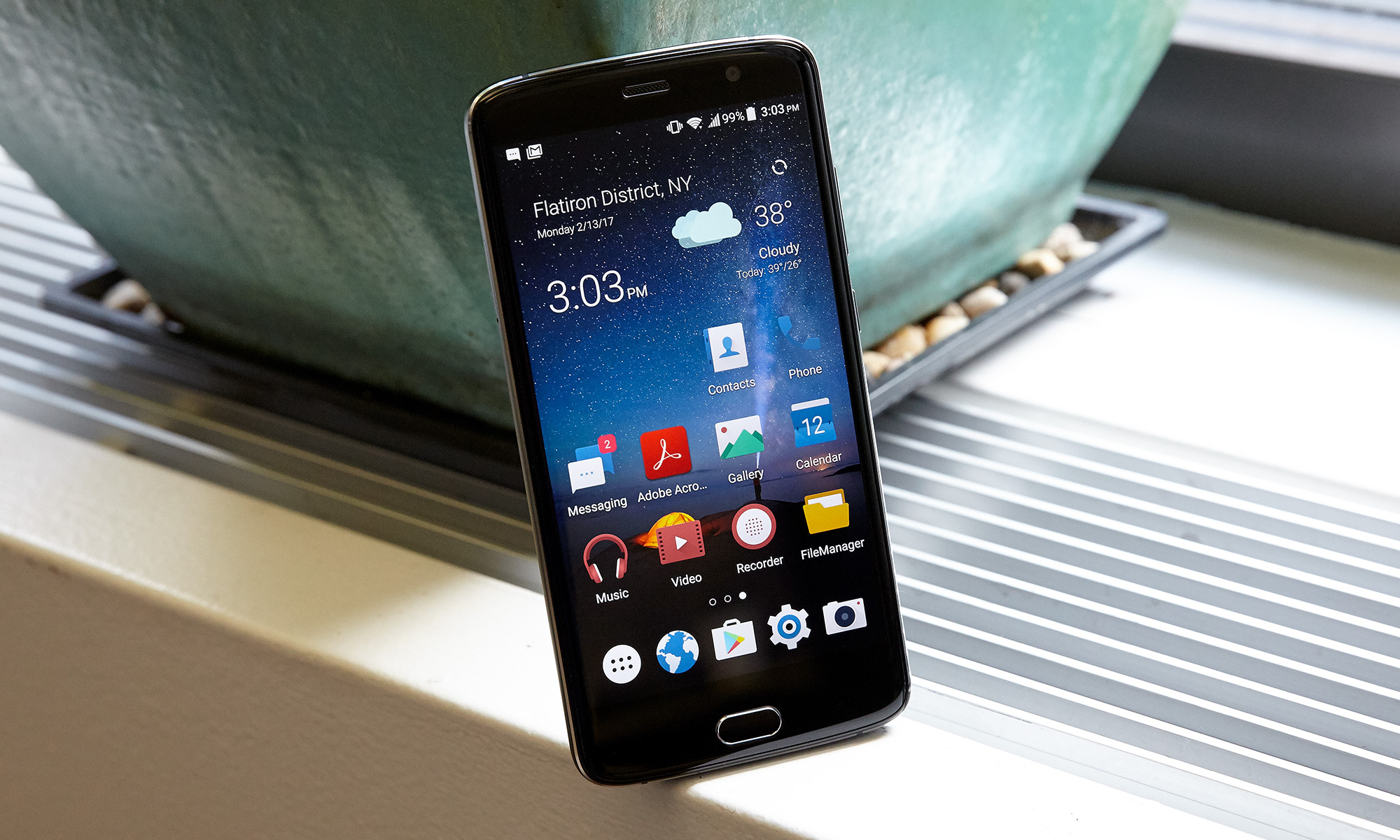Tom's Guide Verdict
The ZTE Blade V8 Pro's 12-hour battery life, dual rear cameras and fingerprint reader redefine what you should expect from a budget phone.
Pros
- +
Dual rear cameras
- +
Attractive price
- +
Outstanding battery life
- +
Built-in fingerprint reader
Cons
- -
No Android 7.0
- -
Plastic back
Why you can trust Tom's Guide
With premium features trickling down to less expensive smartphones, the budget phone arena has gotten increasingly competitive. Take ZTE's Blade V8 Pro, which matches the impressive $249 Honor 6X with dual rear cameras, a fingerprint reader and big, 5.5-inch, full-HD screen — all for $20 less. These two unlocked phones are each compelling options for budget-minded shoppers who want phones that work on GSM networks like those of AT&T and T-Mobile. But when you consider the Blade V8 Pro's outstanding 12-hour battery life, you wind up with one of the best smartphone values you can buy right now.
Design: Don't look back
The look of the Blade V8 Pro is kind of a tale of two phones. Up front, you get a big, 5.5-inch screen surrounded by a glossy black bezel and a nearly flush home button with a built-in fingerprint sensor that is flanked by capacitive touch menu buttons on either side. It's a pretty slick facade — right up until you flip the phone over.
Around back, the Blade's dual rear camera setup has lenses stacked on top of each other, which is a nice touch. But the phone's nonremovable plastic aft just doesn't feel as premium as the aluminum-clad Honor 6X, even if I do like the Blade's subtle diamond-patterned texture.
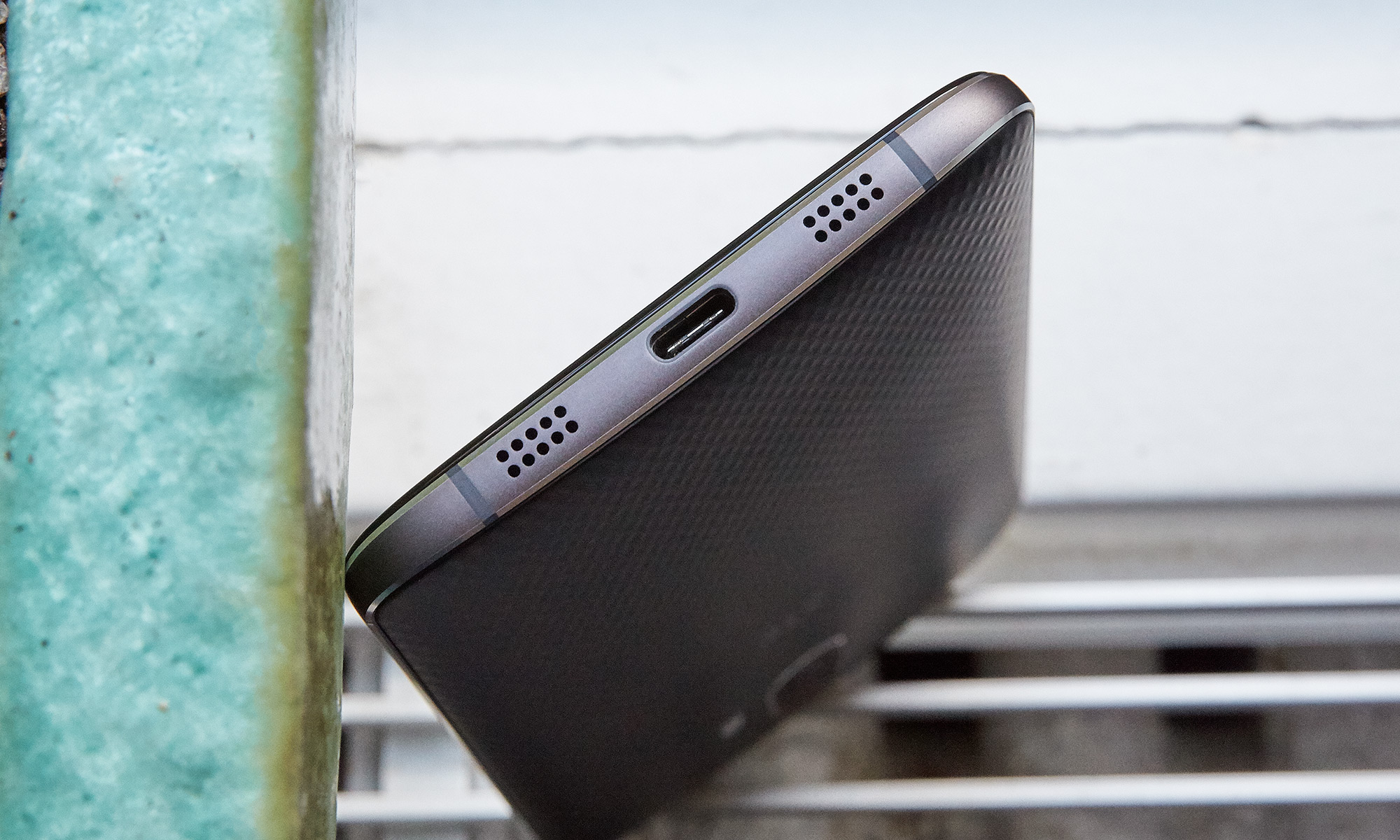
As expected of a 2017 smartphone, there's a USB Type-C port on the bottom of the Blade. However, there's also an "old-school" 3.5mm headphone jack on top. And if you need extra storage, the Blade's dual SIM card tray has one slot that also doubles as a microSD-card reader, capable of adding up to 128GB of storage.
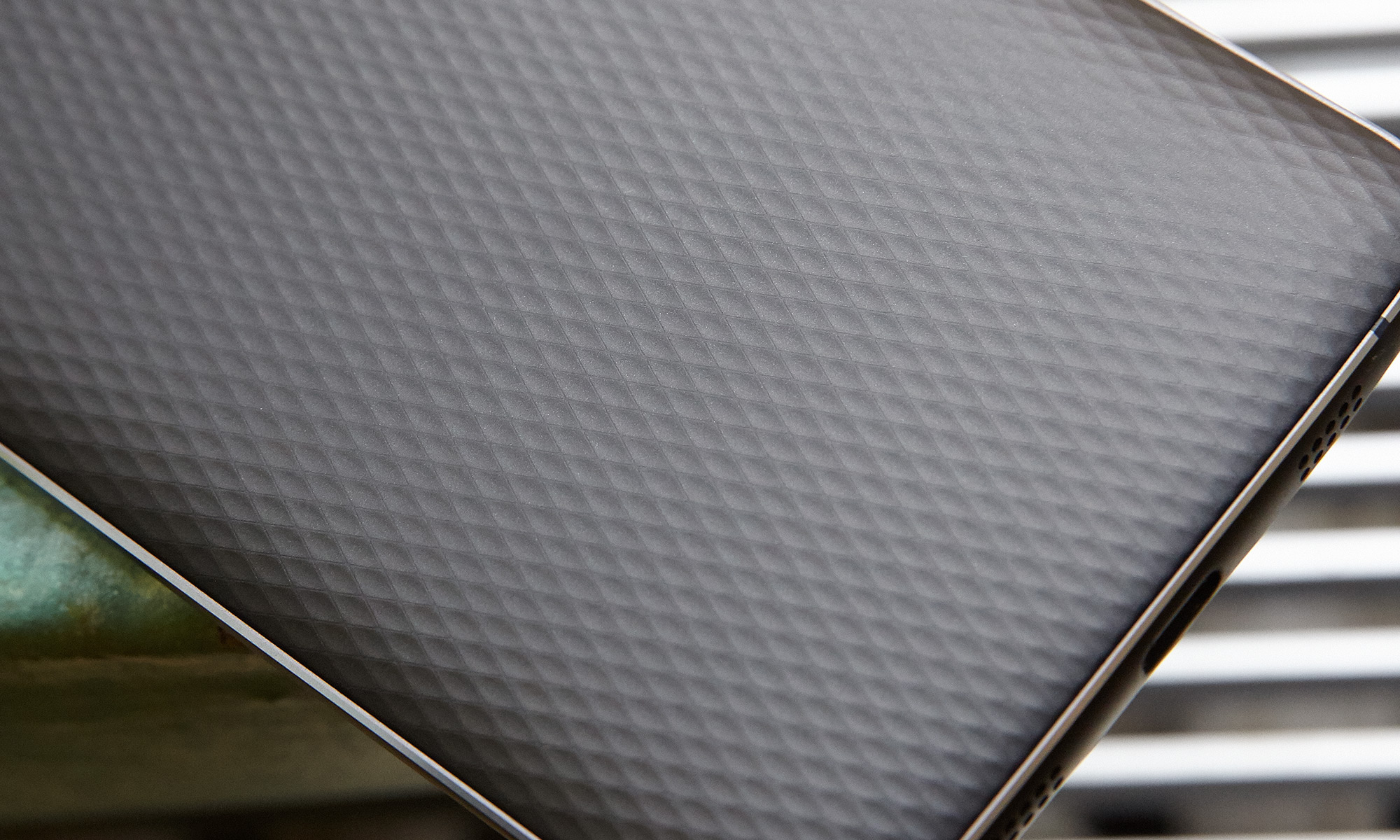
Sizewise, the Blade V8 Pro's dimensions (6.14 x 3.03 x 0.36 inches and 6.53 ounces) fall right in line with those of other 5.5-inch phones. The Honor 6X is a tiny bit smaller and lighter, at 5.94 x 3 x 0.32 inches and 5.71 ounces.
MORE: Best Smartphones on the Market Now
Display: Bright, punchy colors
Even though it's not an OLED display, the Blade V8 Pro's 5.5-inch, full-HD screen sports solid brightness, vivid colors and better contrast than you'd expect on a phone in this price range. It let ZTE's lineup of curated wallpapers sparkle while also making the bright neon lighting in the trailer for John Wick 2 really pop.
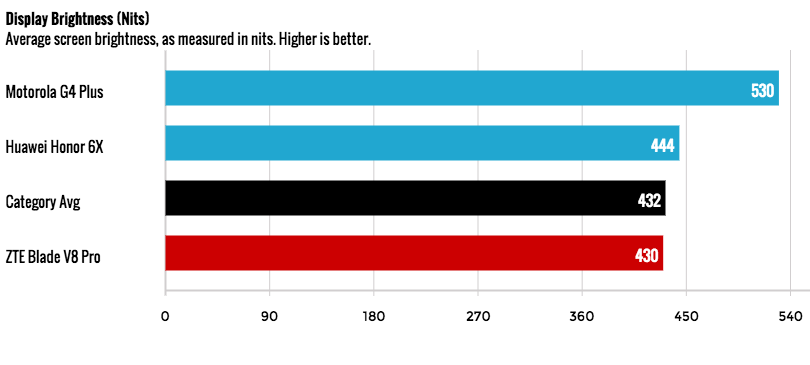
The Blade V8 Pro registered a strong 430 nits of brightness, which is around the 432-nit average for smartphones and on the same level as the 444-nit screen on the Honor 6X. If outdoor visibility is a big concern for you, though, look into the Moto G4 Plus screen, which was even brighter, at 530 nits.
Covering 108 percent of the sRGB spectrum, the Blade's color range also stacks up well against its competition, with the Honor 6X covering 114 percent and the Moto G4 Plus at 108 percent.
Finally, registering a Delta-E rating of 2.16 for color accuracy, the Blade V8 Pro was just barely better than the Moto G4 Plus (2.33), though the gap was a bit wider between the ZTE device and the Honor 6X (3.28) and smartphone average (4.12). (Numbers closer to 0 are better.)
Cameras: Twice as nice
Now that multiple sub-$250 phones offer dual-rear cameras, it's clear this feature will soon come standard on most phones, regardless of price. In the Blade V8 Pro's case, ZTE uses an 8-megapixel camera in front, which delivers solid selfies and two 13MP shooters in back.
ZTE's camera menus do a really good job of highlighting the dual-camera functions by adding an option for Dual next to the standard Photo and Video settings on camera app's mode dial. This immediately calls attention to the camera's extra functionality. When you touch the button, you can select from one of three options: Bokeh, Monocolor and Monochrome.
The latter two options let you take black-and-white photos or photos with selective colors (think of the color styling used in the movie Sin City). Bokeh simulates varying depths of field, like you'd get on a traditional camera with a big lens.
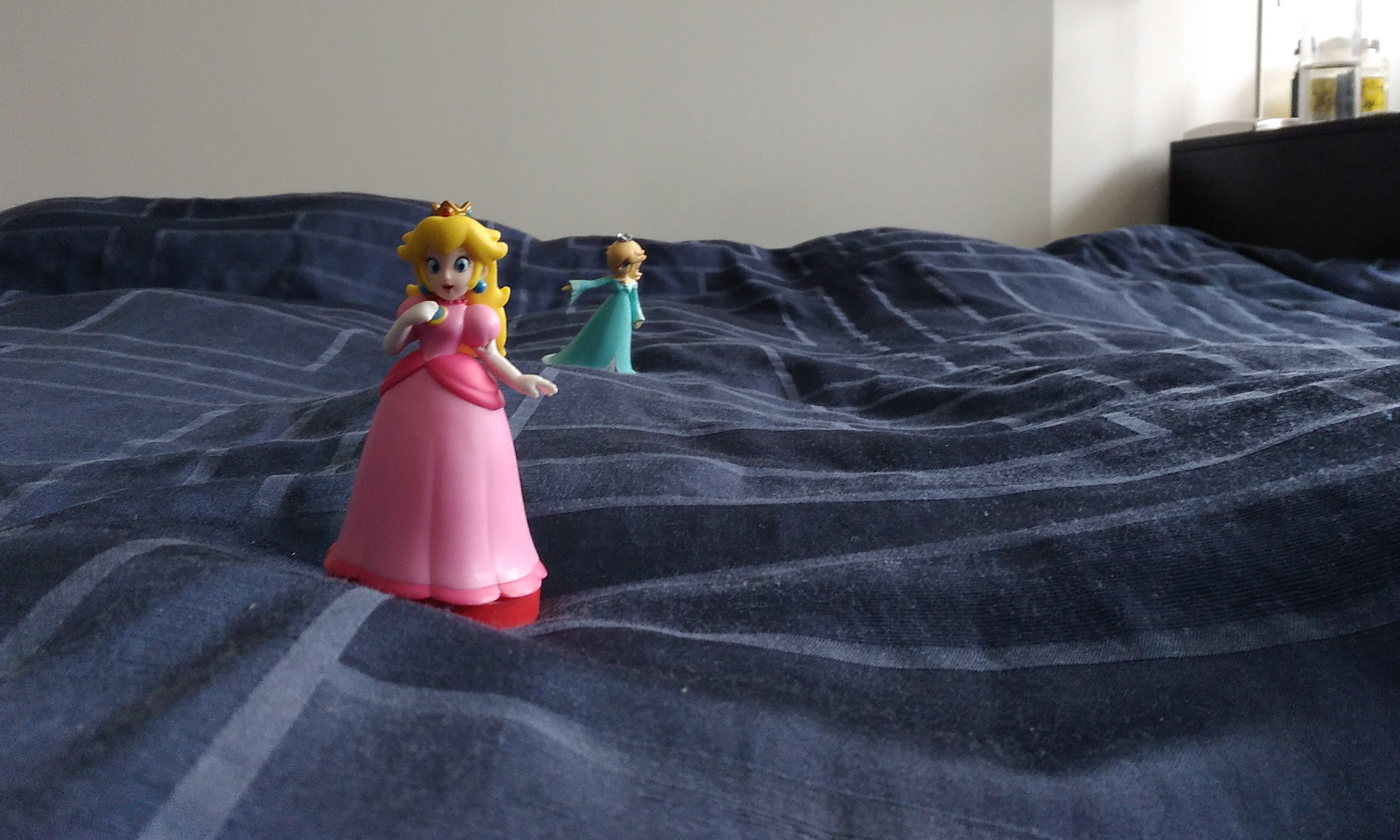
While some people may think this feature is a gimmick, the results can be pretty impressive. When I took a picture of Princess Peach figurine and set the aperture to 0.95, the Blade was able to make the second figure in back almost completely disappear while also blurring out the lamp and nightstand in the background.
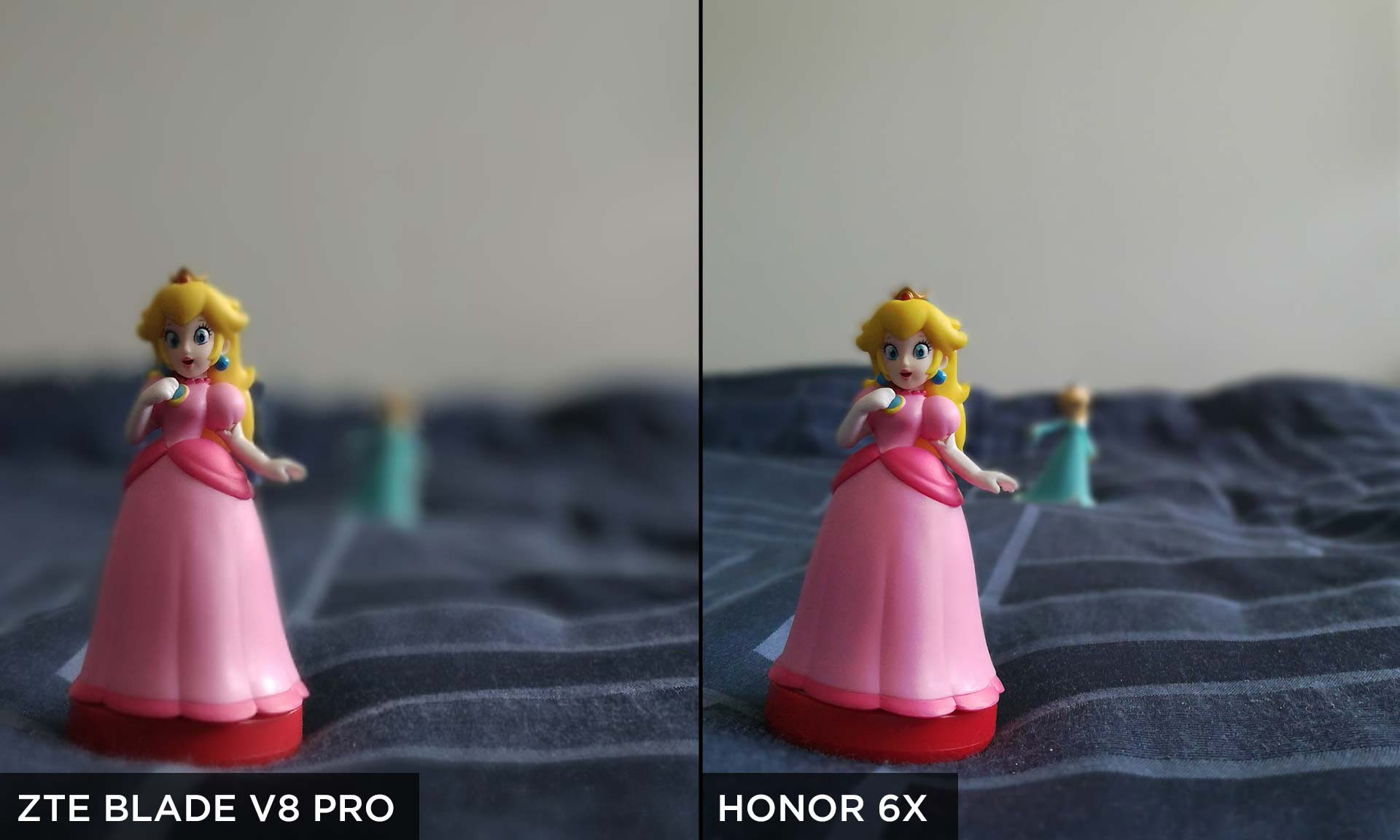
When compared to the same scene shot with a simulated aperture of f/16, the second shot looks much more chaotic due to the deep focus from front to back.
Compared to results from the dual cams on the Honor 6X, the Huawei's pic holds a tiny advantage, thanks to better focus on Peach's face and less aggressive simulated bokeh around her head.
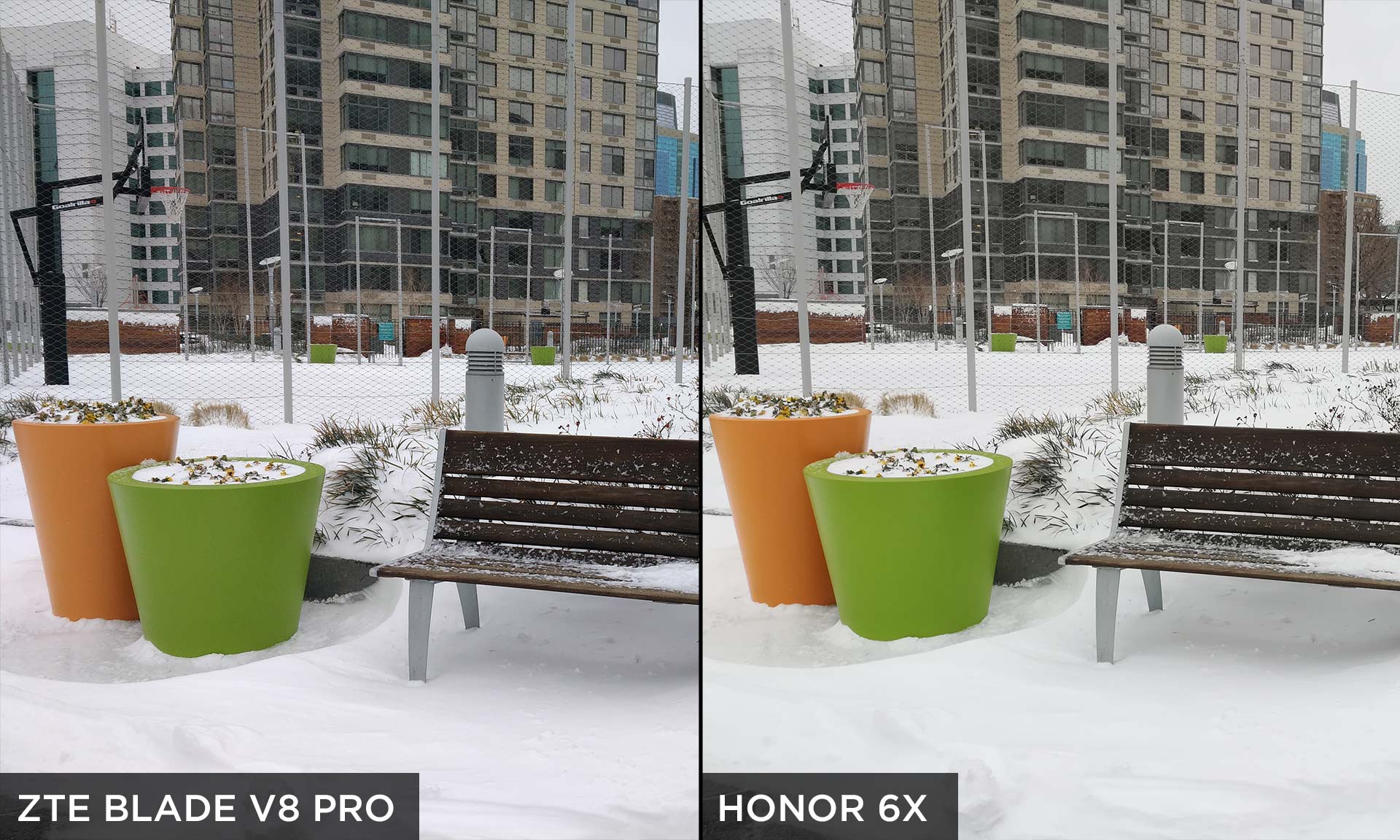
The Honor 6X maintained that advantage in more typical shots as well. For example, the Honor 6X's shot of a snowy bench features a bit more pop in the potted plants' green and orange base, and also on the grays and beiges of the building in the background.
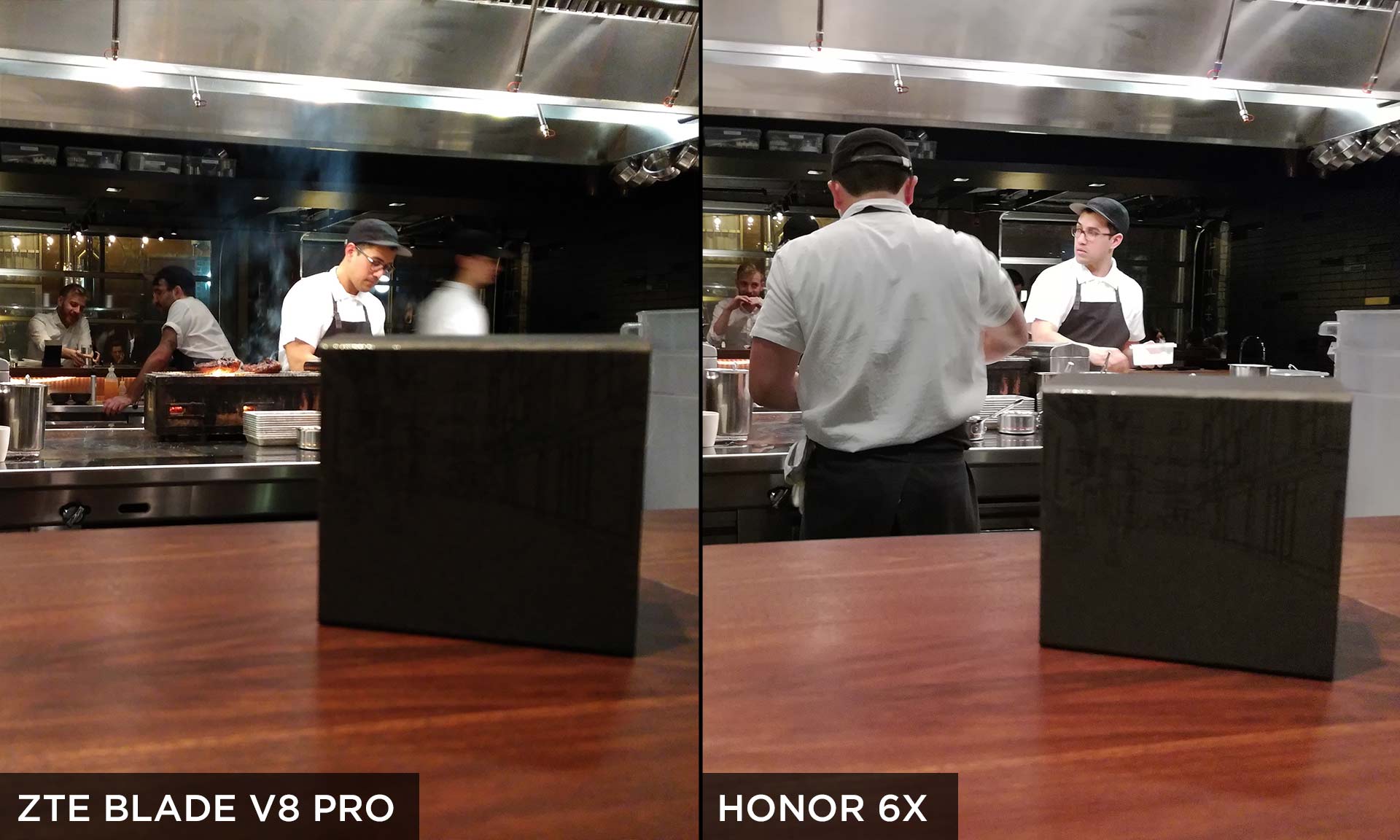
Inside a restaurant, the Blade V8 Pro narrowly lost to the Honor 6X, due to the soft focus and lower contrast on the box in front, which makes illustration on the box harder to identify. However, the Blade V8 Pro captured richer colors in this situation compared to the Honor 6X, as seen in the wood on the counter. This advantage was even more pronounced in a picture of some chicken and aged meat hanging in a refrigerator elsewhere in the restaurant.
Performance: Potent midrange power
Packing a 2GHz Qualcomm Snapdragon 625 CPU, 3GB of RAM and 32GB of storage, the Blade V8 Pro's overall performance compares well to that of its peers, while also demonstrating how Qualcomm still has a small lead in graphics performance for midrange and budget processors. You needn't worry that your phone will bog down while you're playing a game — good news for mobile game junkies like me who want lag-free effects in more demanding games like Star Wars Force Arena and Asphalt 8.
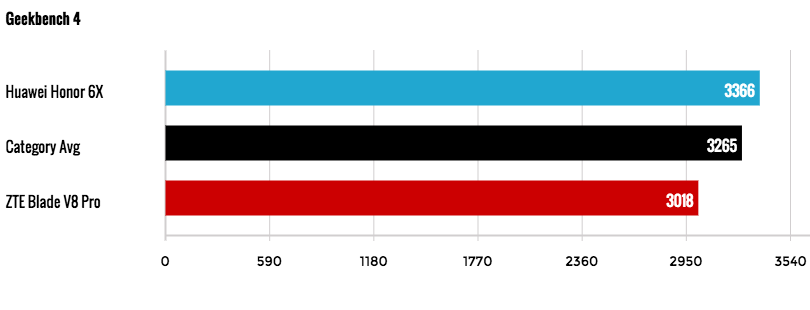
On Geekbench 4, which measures overall performance, the Blade V8 Pro scored 3,018, which is fine for a phone in this price range, although lower than the Honor 6X's showing (3,366) and the current smartphone average (3,265).
However, on the JetStream 1.1 JavaScript benchmark, which tests web-browsing performance, the Blade V8 Pro's score of 30.74 was a touch higher than the Honor 6X's mark of 27.01. (Bigger numbers are better.)
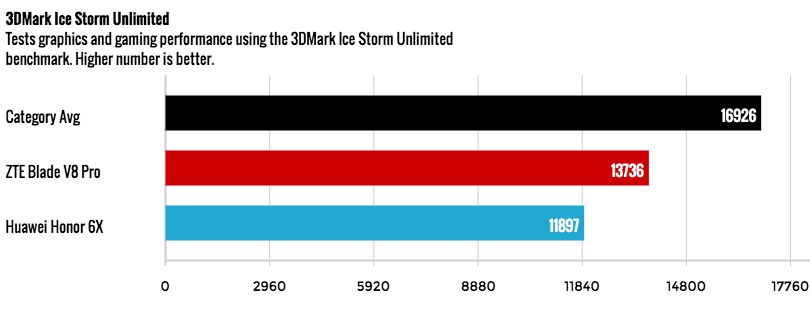
The biggest difference between Blade V8 Pro and the Honor 6X showed up in graphics testing. The Blade V8 Pro with its Adreno 506 GPU scored 13,736 on 3DMark's Ice Storm Unlimited graphics test, versus 11,897 for the Honor 6X and its Mali-T830MP2 GPU.
Software and OS: Close to stock, but still on Android 6.0
The Blade V8 Pro comes with Android 6.0 out of the box, which is about six months behind the most up-to-date version of Google's mobile OS. (The Honor 6X also ships with this older version of Android.) Still, ZTE's implementation is pretty close to stock and doesn't come with a lot of bloat.
ZTE does include a suite of apps for things like file management, clock and calendar, along with pre-installed apps for Dropbox and WeShare. But that's a far cry from the 20-plus unnecessary programs that come on phones you buy from carriers like Sprint or Verizon.
There's also built-in gesture recognition that'll let you perform actions like taking a screenshot using a three-finger pinch, and on-screen buttons for navigating around your phone. However, I don't find the latter that useful for a phone, like the Blade V8 Pro, that already has capacitive-touch buttons.
Battery Life: Top longevity
The Blade V8 Pro's battery life far surpasses the current smartphone average and the longevity of its closest competitors. The phone latest a very impressive 12 hours and 8 minutes on the Tom's Guide Battery Test (which involves continuous web surfing over AT&T's 4G LTE network). Its peers paled in comparison, including the Honor 6X (9:56) and the Moto G4 Plus (9:16).
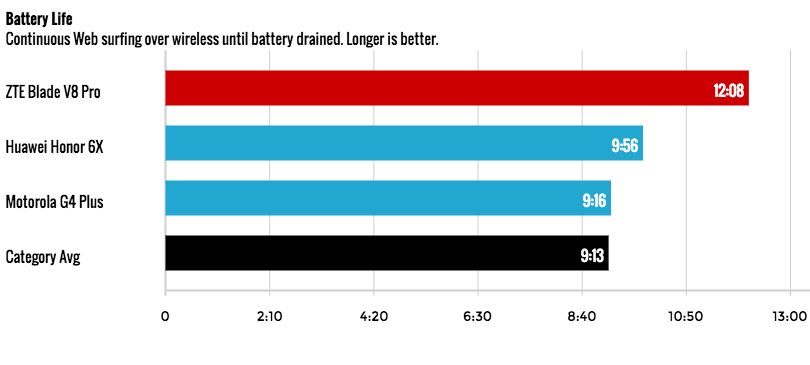
In fact, the Blade V8 Pro's endurance is superior enough to propel it onto our list of the smartphones with the longest battery life.
MORE: Best Cheap Unlocked Smartphones
Bottom Line
Right now, the ZTE Blade V8 Pro and the Honor 6X are easily the cream of the budget phone crop, so much so that choosing between the two is difficult. Both phones have bright, 5.5-inch, full-HD screens, along with dual rear cameras and built-in fingerprint readers. They also share the same flaw in that they're shipping with an outdated version of Android.
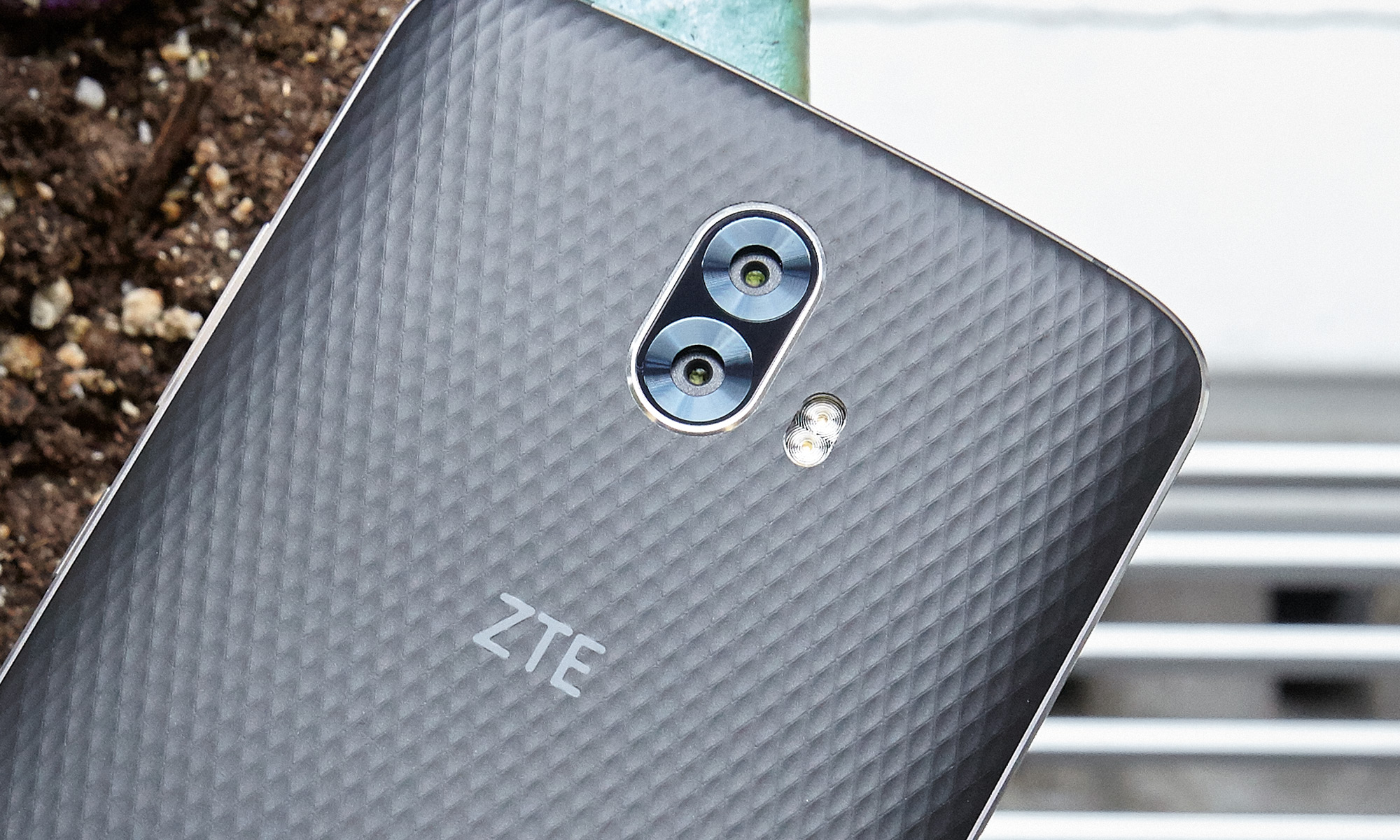
The Honor 6X feels a bit more premium because of its aluminum back and slightly sleeker dimensions. But with a regular price of $250, it also costs $20 more than the ZTE. Meanwhile the Blade V8 Pro has better graphics performance, a slightly better camera and much longer battery life, simplifying the decision for users who demand more from their phones.
Overall, the ZTE Blade V8 Pro is an absolutely fantastic phone, and it's our top pick for a phone costing under $250.
Sam is a Senior Writer at Engadget and previously worked at Gizmodo as a Senior Reporter. Before that, he worked at Tom's Guide and Laptop Mag as a Staff Writer and Senior Product Review Analyst, overseeing benchmarks and testing for countless product reviews. He was also an archery instructor and a penguin trainer too (really).
-
libraloganoo7 What about it being a phone? How is the signal strength and is the earpiece loud and clear?Reply
